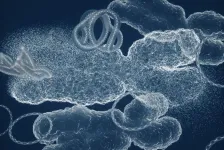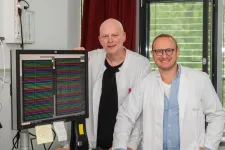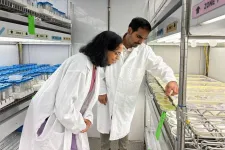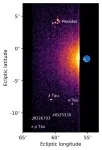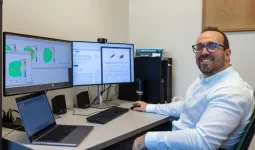(Press-News.org) Scientists discover viral trapdoor blocking HIV and herpes
Ghent, 10 October 2024 – A group of researchers led by Xavier Saelens and Sven Eyckerman at the VIB-UGent Center for Medical Biotechnology discovered how a protein linked to the human immune system wards off HIV-1 and herpes simplex virus-1 by assembling structures in the cell that lure in these viruses and then trap them or even take them apart. The research was spearheaded by first author George Moschonas, published in Cell Host and Microbe, and could be used to devise new strategies to combat these viruses.
The innate immune system of the human body can sense and respond to viruses by producing alarm cytokines, most notably interferons. These proteins act as an alarm system that goes off when a cell is infected by a virus, warning surrounding cells of an invasion and prompting them to activate their antiviral defenses. These defenses comprise so-called interferon-stimulated genes (ISGs), which produce specific proteins with antiviral qualities. One example of this is the MX protein, which was discovered 60 years ago and restricts a broad range of viruses, including those that cause AIDS and herpes.
To date, researchers were unsure how the antiviral properties of the MX protein worked. However, in this new study led by Xavier Saelens and Sven Eyckerman of the VIB-UGent Center for Medical Biotechnology and in collaboration with Beate Sodeik (Hannover Medical School), Zeger Debyser (KU Leuven), Linos Vanderkerckhove (UGent) and Nico Callewaert (VIB-UGent), the secret of the MX protein’s antiviral activity was uncovered.
A virus decoy
A herpes or HIV virus delivers its genome in the host cell nucleus through the nuclear pore complex. This delivery is essential for the virus to launch its genetic program, hijack the cell’s machinery and propagate. As a result, new viruses are made, that leave the cell and spread to surrounding cells.
In an illuminating discovery, the researchers show how the MX protein drives the assembly of virus decoy structures that mimic nuclear pore complexes.
Sven Eyckerman: “We noticed that incoming viruses were being lured into structures that resembled nuclear pores. Through proteomics screens, we found that the MX protein interacts with proteins that are part of the nuclear pore complex. On closer inspection, we discovered that the MX protein orchestrates the assembly of nucleoporins into biomolecular condensates, membrane-less droplets inside a cell that act like a separate compartment. Viruses mistake these condensates for the actual cell door to the cell nucleus and get trapped or punctured."
Xavier Saelens: “By tricking viruses into prematurely releasing their genetic material, the MX protein ultimately prevents the spread of viral infections. This discovery not only clarifies how MX proteins combat viruses but also opens up potential new avenues for antiviral therapies.”
END
Scientists discover viral trapdoor blocking HIV and herpes
2024-10-09
ELSE PRESS RELEASES FROM THIS DATE:
Study uncovers mutations and DNA structures driving bladder cancer
2024-10-09
How bladder cancer originates and progresses has been illuminated as never before in a study led by researchers at Weill Cornell Medicine and the New York Genome Center. The researchers found that antiviral enzymes that mutate the DNA of normal and cancer cells are key promoters of early bladder cancer development, and that standard chemotherapy is also a potent source of mutations. The researchers also discovered that overactive genes within abnormal circular DNA structures in tumor cells genes drive bladder cancer resistance to therapy. These findings are novel insights into bladder cancer biology and point to new therapeutic strategies for this ...
A matter of taste: Electronic tongue reveals AI inner thoughts
2024-10-09
UNIVERSITY PARK, Pa. — A recently developed electronic tongue is capable of identifying differences in similar liquids, such as milk with varying water content; diverse products, including soda types and coffee blends; signs of spoilage in fruit juices; and instances of food safety concerns. The team, led by researchers at Penn State, also found that results were even more accurate when artificial intelligence (AI) used its own assessment parameters to interpret the data generated by the electronic tongue.
The researchers published their results today (Oct. 9) in Nature.
According to the researchers, ...
Another step towards decoding smell
2024-10-09
We often only realize how important our sense of smell is when it is no longer there: food hardly tastes good, or we no longer react to dangers such as the smell of smoke. Researchers at the University Hospital Bonn (UKB), the University of Bonn and the University of Aachen have investigated the neuronal mechanisms of human odor perception for the first time. Individual nerve cells in the brain recognize odors and react specifically to the smell, the image and the written word of an object, for example a banana. The results of this study close a long-standing knowledge gap between animal and human odor research and have now been published in the renowned ...
Plant Science Research collaboration will explore key mosses critical to storing carbon
2024-10-09
ST. LOUIS, MO, October 9, 2024 - Plant scientists at the Donald Danforth Plant Science Center and the HudsonAlpha Institute for Biotechnology have been awarded a four-year National Science Foundation (NSF) Enabling Discovery through GEnomics (EDGE) grant to advance their understanding of sphagnum moss, a crucial component of peatlands and a vital player in global ecosystems. The collaborative research team will develop genetic and genomic resources to study sphagnum's life cycle, growth, and adaptation to various environmental conditions.
Sphagnum ...
Researchers examine the persistence of invisible plastic pollution
2024-10-09
Plastic pollution – tiny bits of plastic, smaller than a grain of sand – is everywhere, a fact of life that applies even to newborn rodents, according to a Rutgers Health study published in the journal Science of the Total Environment.
Researchers have long understood that micro- and nanoplastic particles (MNPs), which enter the environment through oxidation and natural degradation of consumer products, are easily deposited in the human body through inhalation, absorption and diet.
Experts also understand that these pollutants can cross the placental barrier and deposit ...
Coffee during pregnancy safe for baby’s brain development
2024-10-09
A University of Queensland-led study has failed to find any strong links between drinking coffee during pregnancy and neurodevelopmental difficulties in children, but researchers are advising expectant mothers to continue following medical guidelines on caffeine consumption.
Dr Gunn-Helen Moen and PhD student Shannon D’Urso from UQ’s Institute for Molecular Bioscience (IMB) led an in-depth genetic analysis of data from tens of thousands of families in Norway.
“Scandinavians are some of the biggest coffee consumers in the world, drinking at least 4 cups a day, with little stigma about drinking coffee during pregnancy,” ...
SwRI-led instrument aboard Jupiter-bound spacecraft nails in-flight test
2024-10-09
SAN ANTONIO — October 9, 2024 —As European Space Agency (ESA)’s Jupiter Icy Moons Explorer (Juice) spacecraft hurtled past the Moon and Earth in mid-August to provide its first gravity assist maneuver to the Jovian system, the Southwest Research Institute-led Ultraviolet Spectrograph (UVS) instrument imaged the UV emissions radiating from the Earth and Moon.
It was a successful test of one of three science instrument projects comprising NASA’s contribution to ESA’s Juice mission. The UVS data collected were then analyzed and found to be consistent with expectations for the Moon and the Earth. This confirmation that the instrument works ...
New AI models of plasma heating lead to important corrections in computer code used for fusion research
2024-10-09
New artificial intelligence (AI) models for plasma heating can do more than was previously thought possible, not only increasing the prediction speed 10 million times while preserving accuracy, but also correctly predicting plasma heating in cases where the original numerical code failed. The models will be presented on October 11 at the 66th Annual Meeting of the American Physical Society Division of Plasma Physics in Atlanta.
“With our intelligence, we can train the AI to go even beyond the limitations ...
Study: Rise in English learner students in “new destination” states helps, does not hurt, academic outcomes for existing students
2024-10-09
Washington, October 9, 2024—English learner (EL) students represent the fastest growing student group in the United States over the past two decades, with numbers of EL students in public schools soaring in “new destination” states across the South and Midwest. Some commentators have expressed concerns about the possible adverse effect of immigrant students on current students if they require additional resources that are diverted from their peers.
However, a new study finds significant positive spillover effects ...
LANDFEED project kicks off: Transforming agro-food waste into bio-based fertilizers to support Europe’s circular economy
2024-10-09
The LANDFEED project, co-funded by the European Union, held its official kick-off meeting on 12-13 September in Bilbao, Spain. Coordinated by Miriam Pinto from NEIKER, LANDFEED brings together experts across Europe to implement sustainable, circular solutions to Europe’s waste challenges, helping to increase the continent's self-sufficiency in agricultural resources while reducing environmental impact.
LANDFEED will focus on converting under-utilised waste from the agri-food industry, forestry, urban centres, and the natural environment into ...
